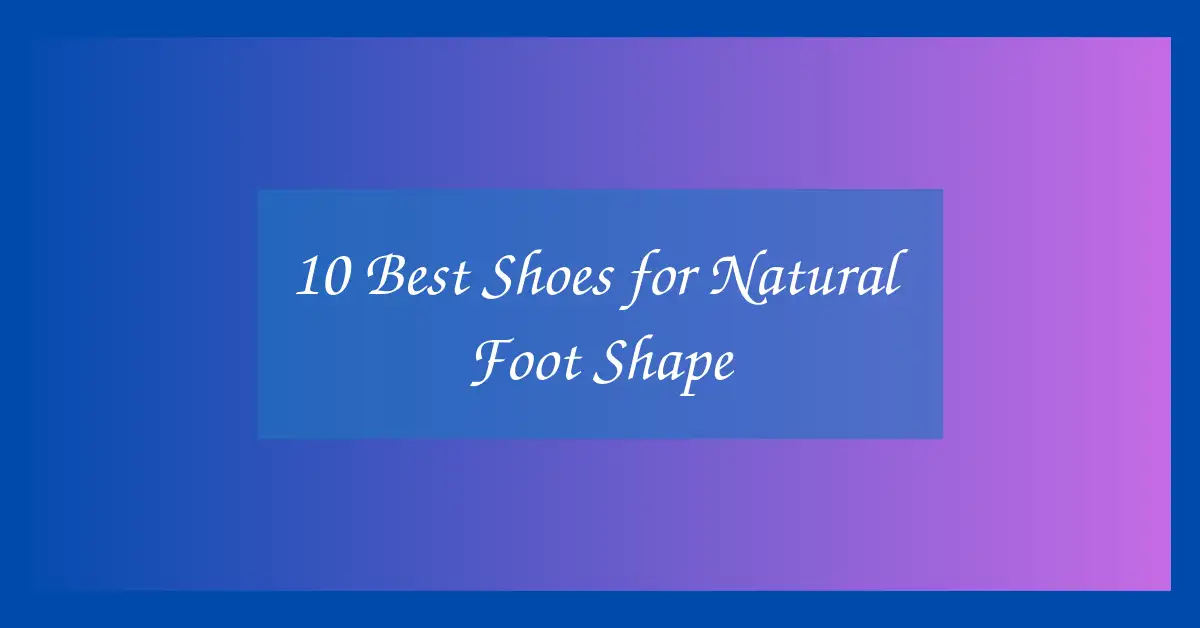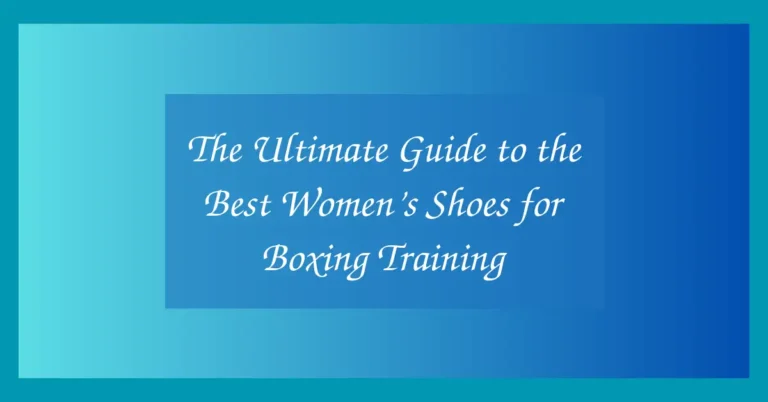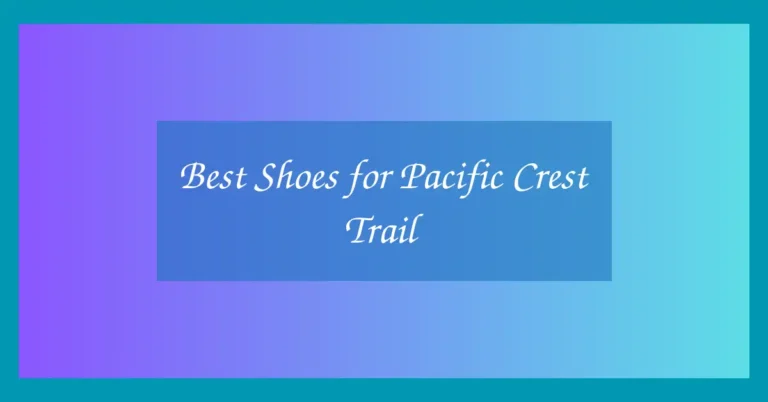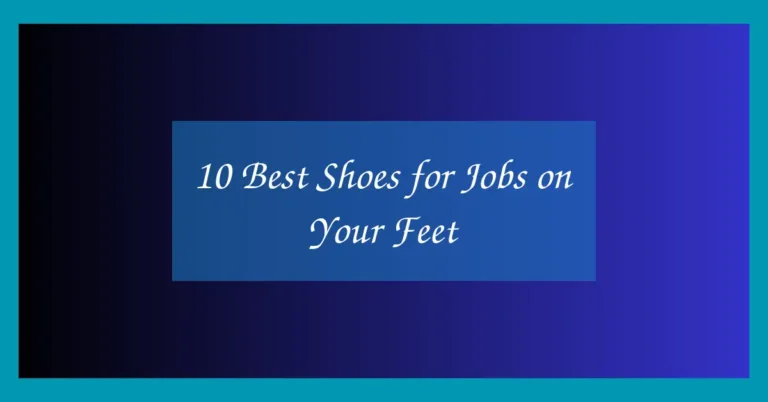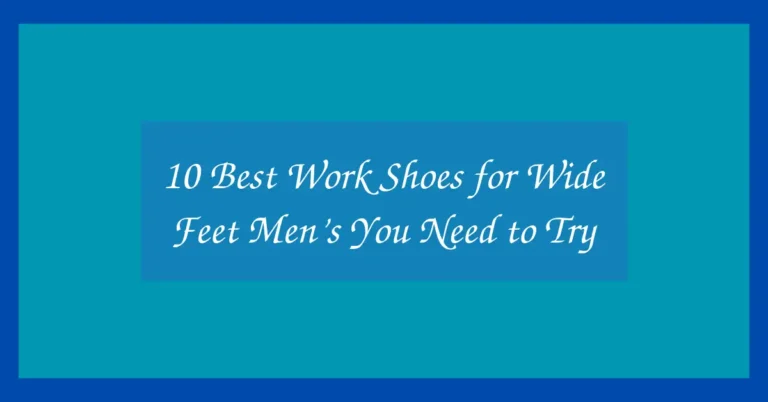10 Best Shoes for Natural Foot Shape
Choosing the right shoes for a natural foot shape is more than a matter of style; it’s essential for maintaining foot health, comfort, and overall body alignment. The right footwear can drastically reduce the risk of injuries and enhance performance in daily activities and sports. For individuals with a natural foot shape, it’s crucial to select shoes that support the foot’s natural arch and contour, allowing for natural movement and alignment. This ensures not only comfort but also promotes a healthy gait, minimizing stress on the ankles, knees, and hips. In this guide, we will explore how to pick the best shoes that align with your natural foot shape, enhancing your safety and performance in every step.
Top 10 Shoe Reviews for Natural Foot Shape
When it comes to selecting the right footwear for a natural foot shape, it’s important to choose shoes that offer excellent support, comfort, and durability while respecting the natural form of the foot. Below, we detail the top 5 shoes that meet these criteria, complete with pros and cons for each option.
1. Altra Escalante 2.5
The Altra Escalante 2.5 is a popular choice among those who prioritize a natural foot shape, thanks to its balanced cushioning and zero-drop platform. The upper is made from a lightweight, breathable knit that molds to the foot for a sock-like fit, enhancing comfort without restricting movement.
Review:
-
Comfort and Fit: The Escalante 2.5 is renowned for its FootShape toe box, which allows the toes to spread naturally, maintaining proper alignment and balance.
-
Performance: Its zero-drop design encourages a more natural midfoot strike, which can reduce impact and improve stability during runs or walks.
-
Material Quality: The knit upper provides not only excellent breathability but also durability, holding up well against frequent use.
-
Versatility: This model is versatile enough for both running and casual wear, thanks to its stylish design and responsive cushioning.
-
Overall Experience: Users often report a noticeable improvement in comfort and a reduction in foot fatigue, even after prolonged periods of wear.
Pros:
-
Wide toe box allows natural toe spread
-
Zero-drop for natural alignment
-
Responsive and comfortable cushioning
-
Durable and breathable knit upper
-
Suitable for running and everyday use
Cons:
-
May not provide enough support for severe overpronators
-
Slightly higher price point
2. Merrell Vapor Glove 4
The Merrell Vapor Glove 4 is a minimalist shoe that offers an almost barefoot experience, ideal for those looking to mimic natural foot movements while receiving a bit of protection.
Review:
-
Comfort and Fit: Designed to mimic the shape of the human foot, the Vapor Glove 4 offers a snug fit with a highly flexible sole for natural movement.
-
Performance: The thin, non-cushioned sole allows for excellent ground feedback, essential for improving balance and agility.
-
Material Quality: Made with a durable mesh and TPU upper, the shoe provides both breathability and a lightweight feel.
-
Versatility: While primarily designed for trail running and hiking, its sleek design also fits well in an urban environment.
-
Overall Experience: Users appreciate the glove-like fit and the true barefoot-like experience, although some may need time to adapt to the minimal cushioning.
Pros:
-
Ultra-lightweight and flexible
-
Enhances natural foot movement
-
Durable construction
-
Breathable material
-
Good ground feedback for balance and proprioception
Cons:
-
Minimal protection and cushioning
-
Not suitable for rough terrains or heavy impact activities
3. Brooks PureFlow 7
Brooks PureFlow 7 supports a natural foot shape while providing enough cushioning to handle long durations on your feet, making it a great hybrid between traditional and natural footwear styles.
Review:
-
Comfort and Fit: It features a rounded heel and a wide toe box that mimic the foot’s natural shape, promoting organic movement.
-
Performance: The BioMoGo DNA midsole offers adaptive cushioning, which adjusts to your specific weight, pace, and stride.
-
Material Quality: The mesh upper is flexible yet supportive, enhancing the shoe’s overall durability and breathability.
-
Versatility: Equally at home on the track or at the gym, the PureFlow 7 is also stylish enough for casual wear.
-
Overall Experience: The transition from heel to toe is smooth, and many users report reduced pressure on joints due to the shoe’s excellent shock absorption.
Pros:
-
Adaptive cushioning technology
-
Wide toe box and natural fit
-
Durable and breathable upper
-
Versatile design for multiple activities
-
Smooth heel-to-toe transition
Cons:
-
Some users find the cushioning too soft for high-impact activities
-
Limited color options
4. Vivobarefoot Primus Lite
Vivobarefoot Primus Lite is designed for those who want to strengthen and condition their feet while ensuring a near-barefoot experience.
Review:
-
Comfort and Fit: This shoe offers an ultra-thin sole and a wide toe box that encourage natural foot flexibility and toe splay.
-
Performance: The PRO5 ultra-thin, puncture-resistant layer in the sole provides just enough protection without compromising sensory feedback.
-
Material Quality: Made from recycled materials, the Primus Lite is not only good for your feet but also for the environment.
-
Versatility: It’s incredibly versatile for physical training, running, or as an everyday shoe thanks to its minimalistic design.
-
Overall Experience: Most users love the lightweight design and eco-friendly materials, though it takes some getting used to the minimal cushioning.
Pros:
-
Promotes foot strength and health
-
Puncture-resistant yet thin sole
-
Eco-friendly materials
-
Lightweight and flexible
-
Encourages natural foot movement
Cons:
-
Minimal protection may not be suitable for all environments
-
Price point is relatively high for minimalist shoes
5. Nike Free RN 5.0
Nike Free RN 5.0 offers a balance between traditional running shoes and those designed for a natural foot shape, featuring flexible grooves that mimic the biomechanics of a barefoot run.
Review:
-
Comfort and Fit: Its low-profile cushioning and a rounded heel enhance alignment and encourage a natural footstrike.
-
Performance: The laser-cut grooves on the sole provide flexibility and adapt to every step, promoting efficient strides.
-
Material Quality: The single-layer mesh and synthetic upper offers a second-skin feel that is both stretchy and secure.
-
Versatility: This shoe is perfect for short to moderate runs and high-intensity training.
-
Overall Experience: Users often highlight the shoe’s flexibility and lightweight nature, providing a freeing experience, though some wish for more arch support.
Pros:
-
Flexible sole with deep grooves
-
Lightweight and supportive upper
-
Low-profile cushioning for a natural feel
-
Encourages natural foot alignment
-
Good for a variety of workouts
Cons:
-
Limited arch support
-
Not ideal for long-distance runners
6. Topo Athletic Magnifly 3
Topo Athletic’s Magnifly 3 is designed with a roomy toe box and a zero-drop platform, ideal for those who prefer a natural ride without compromising on cushioning.
Review:
-
Comfort and Fit: Features a roomy toe box that allows the toes to spread naturally, enhancing stability and comfort.
-
Performance: The dual-density midsole offers a softer top layer for comfort and a firmer bottom layer for propulsion, facilitating a responsive ride.
-
Material Quality: Constructed with a breathable mesh upper that ensures durability and keeps feet cool during long runs.
-
Versatility: Great for road running, light trail use, and daily training.
-
Overall Experience: Users appreciate the blend of responsiveness and cushioning, making it suitable for longer distances without altering natural foot movements.
Pros:
-
Roomy toe box for natural toe splay
-
Dual-density midsole for comfort and responsiveness
-
Durable and breathable mesh upper
-
Versatile for various running environments
-
Zero-drop for natural foot alignment
Cons:
-
May not provide enough arch support for some users
-
Limited style options
7. New Balance Minimus 10 V1
The New Balance Minimus 10 V1 is a minimalist trail running shoe that provides a close-to-earth feel while offering adequate protection and durability for rugged terrains.
Review:
-
Comfort and Fit: Offers a snug fit with minimal cushioning to promote a more natural foot strike.
-
Performance: The Vibram outsole ensures excellent traction on varied surfaces, and the thin midsole enhances ground contact.
-
Material Quality: Made with a durable synthetic mesh that withstands environmental elements while maintaining breathability.
-
Versatility: Ideal for trail running and hiking, but also suitable for gym workouts due to its lightweight design.
-
Overall Experience: Users love the tactile feedback and protection, though it may take time to adjust to the minimal cushioning.
Pros:
-
Lightweight and responsive
-
Excellent traction with Vibram outsole
-
Durable and breathable upper
-
Enhances natural foot mechanics
-
Suitable for trails and gym use
Cons:
-
Minimal cushioning may not suit everyone
-
Requires gradual adaptation for comfort
8. Skechers Go Walk 5
Skechers Go Walk 5 is excellent for daily wear, designed with innovative comfort features that cater to walking and standing for long periods.
Review:
-
Comfort and Fit: Equipped with a breathable mesh upper and a supportive, cushioned insole that molds to the foot.
-
Performance: The responsive ULTRA GO cushioning and high-rebound COMFORT PILLAR TECHNOLOGY™ underfoot react to your every step for the ultimate comfort.
-
Material Quality: The soft mesh fabric upper and lightweight synthetic overlays add durability without the bulk.
-
Versatility: Perfect for casual walking, shopping, or day-to-day wear.
-
Overall Experience: Users report exceptional comfort and support, making it a favorite for those needing all-day wearability.
Pros:
-
High level of cushioning and support
-
Breathable and lightweight mesh upper
-
Versatile for daily use
-
Reactive cushioning technology
-
Wide fit available
Cons:
-
Not suitable for running or high-impact activities
-
Some may find the style too casual
9. Lems Primal 2
Lems Primal 2 is crafted to mirror the natural curvature of the human foot, providing ample room in the toe box and a zero-drop platform for an uninhibited, barefoot feel.
Review:
-
Comfort and Fit: The wide toe box and flexible sole allow for unrestricted movement and natural toe spread.
-
Performance: The low-profile, zero-drop design supports natural posture and balance.
-
Material Quality: Made from vegan-friendly microfiber and air mesh, promoting durability and breathability.
-
Versatility: Suitable for light trail walking, casual wear, and everyday activities.
-
Overall Experience: The shoe is favored for its minimalist design that does not compromise on comfort or freedom of movement.
Pros:
-
Wide toe box for comfort and natural toe movement
-
Zero-drop for proper posture and balance
-
Lightweight and breathable materials
-
Vegan-friendly
-
Functional for multiple low-impact activities
Cons:
-
Not ideal for heavy-duty activities or rough terrains
-
Some users may need more cushioning
10. Inov-8 Bare-XF 210 V3
Designed for athletes who need a balance of protection and sensory feedback, Inov-8 Bare-XF 210 V3 excels in environments where a good grip and flexibility are paramount.
Review:
-
Comfort and Fit: Offers a snug fit with a roomy toe box for freedom of movement.
-
Performance: The sticky rubber outsole provides unmatched grip in wet or dry conditions, ideal for gym workouts or outdoor activities.
-
Material Quality: Features a durable mesh upper that is both lightweight and robust enough to handle rigorous use.
-
Versatility: Excellently suited for fitness classes, lifting, and mixed sports.
-
Overall Experience: Athletes appreciate the blend of protection, grip, and ground feel, making it a top choice for functional fitness enthusiasts.
Pros:
-
Excellent grip with sticky rubber outsole
-
Roomy toe box allows for natural toe spread
-
Durable and lightweight construction
-
Ideal for gym and outdoor activities
-
Provides great sensory feedback
Cons:
-
Minimal cushioning limits long-duration comfort
-
Not targeted toward distance runners
Buyer’s Guide
When searching for the best shoes to accommodate a natural foot shape, several key factors should be considered to ensure you make an informed purchase. Here’s a detailed look at these essential criteria:
1. Shape and Fit: The most important aspect is how the shoe fits the natural contour of your foot. Look for shoes that offer a wide toe box that allows your toes to spread naturally as you walk or run. This is crucial for maintaining balance and proper toe alignment. Avoid shoes that squeeze the toes or force them into an unnatural position.
2. Arch Support: Proper arch support is vital for those with a natural foot arch. Shoes should have adequate arch support that matches the natural curvature of your foot. This support should not be overly rigid or excessively soft. It should comfortably uphold the arch and distribute weight evenly across the foot.
3. Material: The material of the shoe affects its breathability, durability, and how well it conforms to the shape of your foot. Natural materials like leather and canvas adapt to the shape of your foot over time, offering better customization, while synthetic materials can provide greater water resistance and durability. Mesh materials are excellent for breathability and are ideal for athletic shoes.
4. Sole Flexibility: The sole of the shoe should allow for natural foot movement. Look for soles that are flexible enough to bend with your foot but provide enough rigidity to protect from external elements. The right balance will ensure comfort while supporting natural foot biomechanics.
5. Cushioning: Adequate cushioning absorbs impact and reduces stress on joints and bones. However, too much cushioning can impair the natural foot mechanics. Choose a shoe that provides enough cushioning but still allows you to feel the ground slightly for better control of your movements.
6. Durability: Consider the construction quality and materials used in the shoes. Well-constructed shoes will not only last longer but also provide consistent support and comfort as they age. Check the stitching, adhesive, and material quality before purchasing.
7. Grip and Traction: Depending on your activities, the grip of the shoe can be critical. For outdoor activities, look for outsoles that provide adequate grip on various surfaces to prevent slips and falls.
Understanding these factors will help you choose shoes that fit well, support your foot’s natural shape, and enhance your activities, whether they’re for daily wear or specific sports.
FAQ
Q1: Why is it important to choose shoes that fit the natural foot shape?
Choosing shoes that fit the natural foot shape is crucial because it helps maintain proper alignment of the feet, ankles, hips, and spine, reducing the risk of injuries and discomfort during activities.
Q2: How can I tell if a shoe provides adequate arch support for my natural foot shape?
You can tell if a shoe provides adequate arch support by checking if the arch area of the shoe aligns with and supports your foot’s natural arch without causing discomfort or pressure points.
Q3: What should I look for in the sole flexibility of a shoe?
Look for soles that are flexible enough to bend at the ball of the foot but still provide sufficient protection and support for your feet. This balance helps maintain natural foot movements and reduces strain.
Q4: Are expensive shoes always better for natural foot shapes?
Not necessarily. While higher-priced shoes often offer better materials and construction, it’s essential to assess each shoe individually based on fit, support, material, and overall comfort rather than just price.
Q5: How often should I replace my shoes?
The lifespan of shoes can vary based on their quality, material, and how often they are worn. Generally, it’s recommended to replace them once they show signs of wear such as diminished cushioning and degraded grip, or typically every 300-500 miles for running shoes.
Q6: Can I wear minimalist shoes if I have a natural foot shape?
Yes, minimalist shoes can be a good option for those with a natural foot shape as they allow the foot to move more naturally. However, transition gradually to allow your body to adapt to the reduced cushioning and support.
Q7: What type of shoe should I avoid if I have a natural foot shape?
Avoid shoes with a narrow toe box, excessive heel height, or those that do not provide sufficient arch support. These can alter the natural foot position and lead to foot and joint problems.
Conclusion
Selecting the right footwear for a natural foot shape is crucial for ensuring both safety and functionality. The shoes reviewed here offer various features that cater to different needs, from everyday comfort to athletic performance, emphasizing the importance of choosing footwear that supports natural foot mechanics while providing necessary protection and support.

